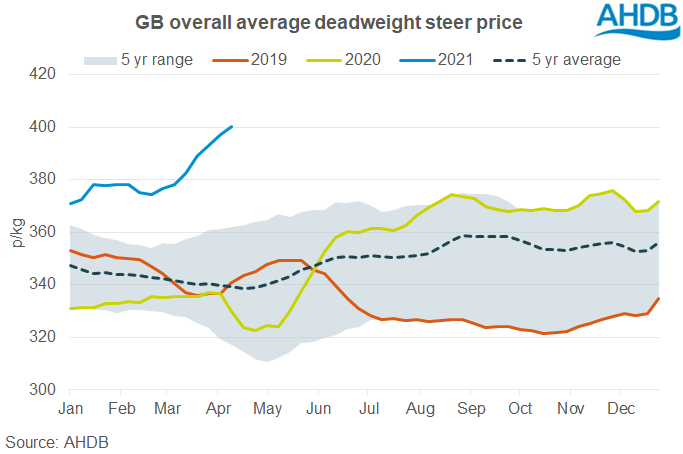Cattle prices pick up again
Wednesday, 14 April 2021
By Bethan Wilkins
The deadweight cattle prices showed another upward movement in the week ended 10 April. Similar to the previous week, the GB all-prime average gained just over 3p to reach 399.3p/kg. This is over 70p/kg more than the equivalent week in 2020, when prices began to fall sharply.
The cumulative increases in recent weeks have been significant, and highlight the strength of the cattle trade at present. Keen retail demand continues to be a feature of the market, and still seems to be keeping demand ahead of supplies coming forward. Estimated prime slaughter during the week totalled 29,500 head, 1% lower than the week before and 6% lower than the same week last year. This week contains a bank holiday, so a year-on-year decline would be expected.
It remains to be seen how the ongoing easing of lockdown, with the next stage planned for 17 May, influences British cattle prices in the coming weeks. Strong retail demand is particularly positive for British beef demand, but as the foodservice market reopens, we might reasonably expect more competition from imported beef through these outlets.
England & Wales and Scotland saw similar trends over the past week:
- E&W Steers: +3.5p to 394.8p/kg
- Scotland Steers: +2.0p to 414.5p/kg
- E&W Heifers: +3.6p to 392.9p/kg
- Scotland Heifers: +3.2p to 417.0p/kg
- E&W Young Bulls: +5.3p to 386.3p/kg
- Scotland Young Bulls: +10.7p to 409.2p/kg
The average GB prices were as follows:
- Overall Steers: +3.1p to 400.2p/kg
- R4L Steers: +1.9p to 408.8p/kg
- Overall Heifers: +3.1p to 399.0p/kg
- R4L Heifers: +1.8p to 408.6p/kg
- Overall Young Bulls: +7.7p/kg to 392.6p/kg
- R3 Young Bulls: +6.5p to 400.6p/kg

Cow trade has also remained robust, with overall GB prices up by over 3p to 273.9p/kg. Those meeting –O4L spec gained 2.4p on the week to reach 290.3p/kg. The overall increase was driven by a nearly 4p price rise in England & Wales, as the overall Scottish price was down by over a penny. However, in-spec cow prices did make gains across GB. Numbers slaughtered were relatively low in the week, with estimates at 8,300 head.
Developments in the dairy industry may influence supplies (and therefore prices) in the coming weeks. While some slight upward pressure on farmgate milk prices has been projected for the spring, due to rising prices on dairy wholesale markets, these are offset by concerns over rising feed costs. In addition, milk production seems to be heading for a record high, which could cause logistical problems processing all of the milk.
Sign up for regular updates
You can subscribe to receive Beef and Lamb market news straight to your inbox. Simply fill in your contact details on our online form.
While AHDB seeks to ensure that the information contained on this webpage is accurate at the time of publication, no warranty is given in respect of the information and data provided. You are responsible for how you use the information. To the maximum extent permitted by law, AHDB accepts no liability for loss, damage or injury howsoever caused or suffered (including that caused by negligence) directly or indirectly in relation to the information or data provided in this publication.
All intellectual property rights in the information and data on this webpage belong to or are licensed by AHDB. You are authorised to use such information for your internal business purposes only and you must not provide this information to any other third parties, including further publication of the information, or for commercial gain in any way whatsoever without the prior written permission of AHDB for each third party disclosure, publication or commercial arrangement. For more information, please see our Terms of Use and Privacy Notice or contact the Director of Corporate Affairs at info@ahdb.org.uk © Agriculture and Horticulture Development Board. All rights reserved.

